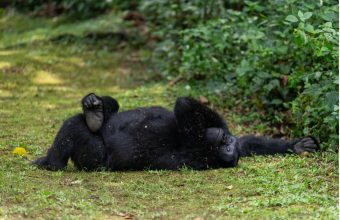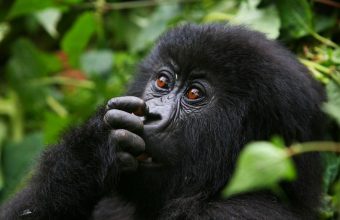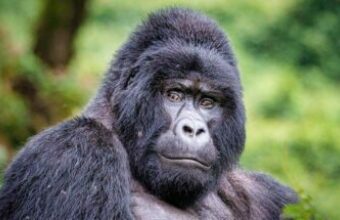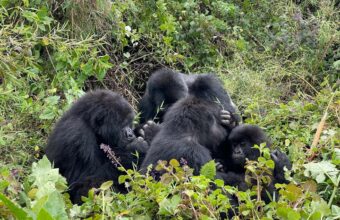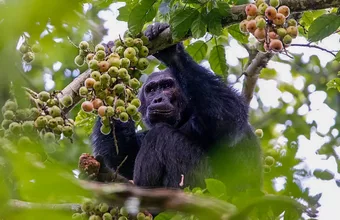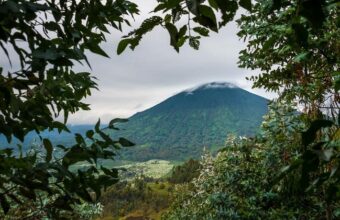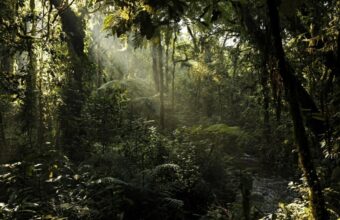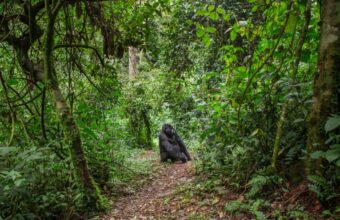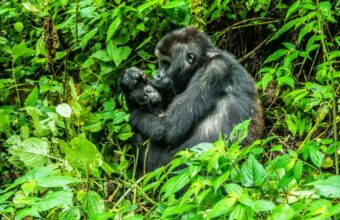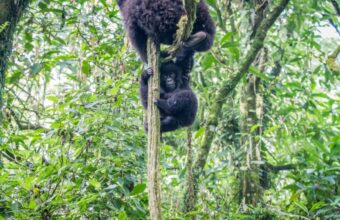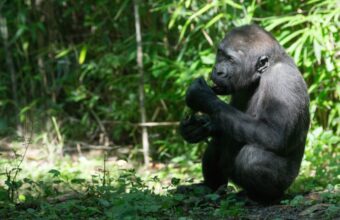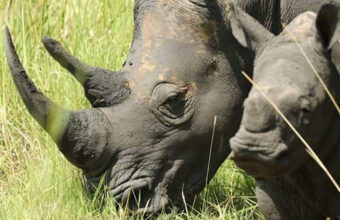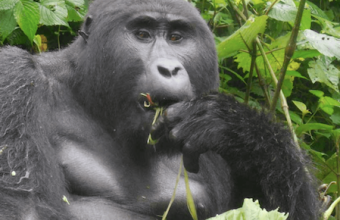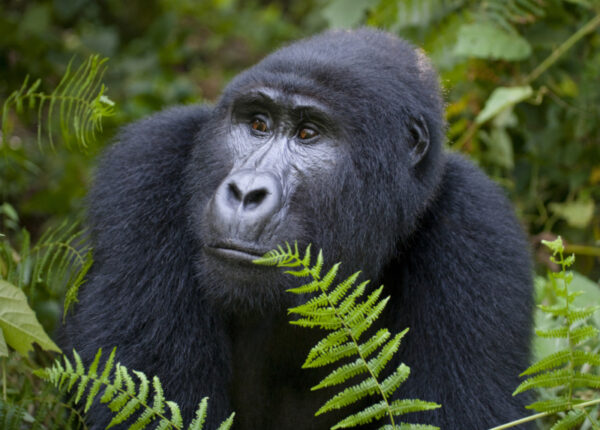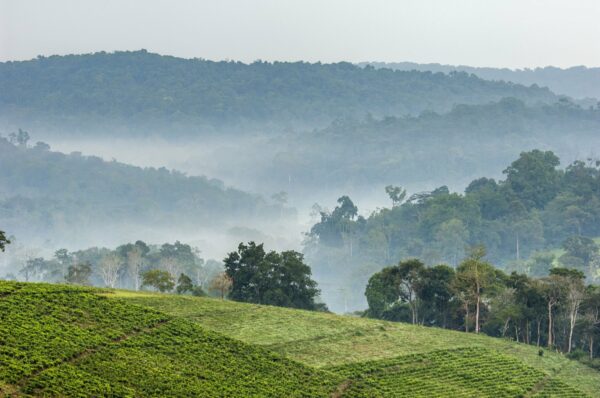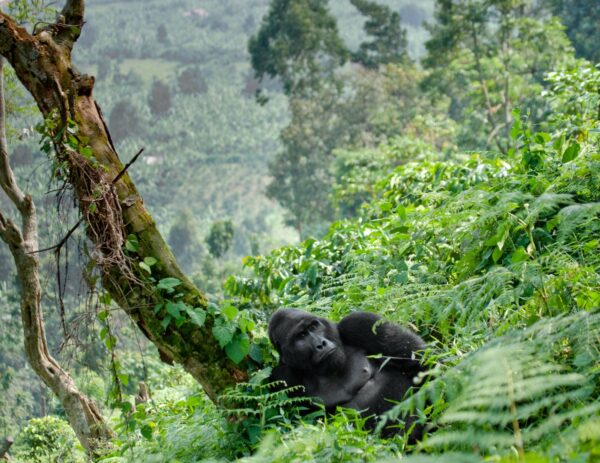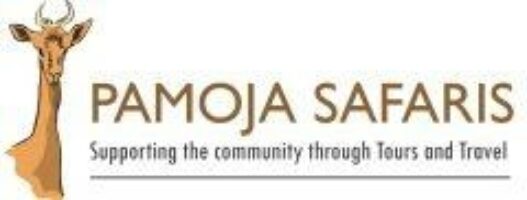Gorilla trekking
The best places to see gorillas in the wild
Gorilla trekking: Introduction
As a guidebook writer specialised in East Africa, I’ve been gorilla trekking at least a dozen times across three different countries. It’s an experience that never gets old. On the contrary, every gorilla encounter is different. You might find yourself sitting a few metres from a barrel-headed silverback as it delicately shreds a bamboo shoot, or exchanging a questioning glance with a curious middle-aged mama, or watching a young hooligan climbing ineptly up a liana and tumbling playfully back to the ground. However your encounter plays out, anybody who has looked into the soft brown eyes of a gorilla will confirm that it is an awesome experience.
Read to go? Here's my expert guide to going gorilla trekking in Rwanda and Uganda.
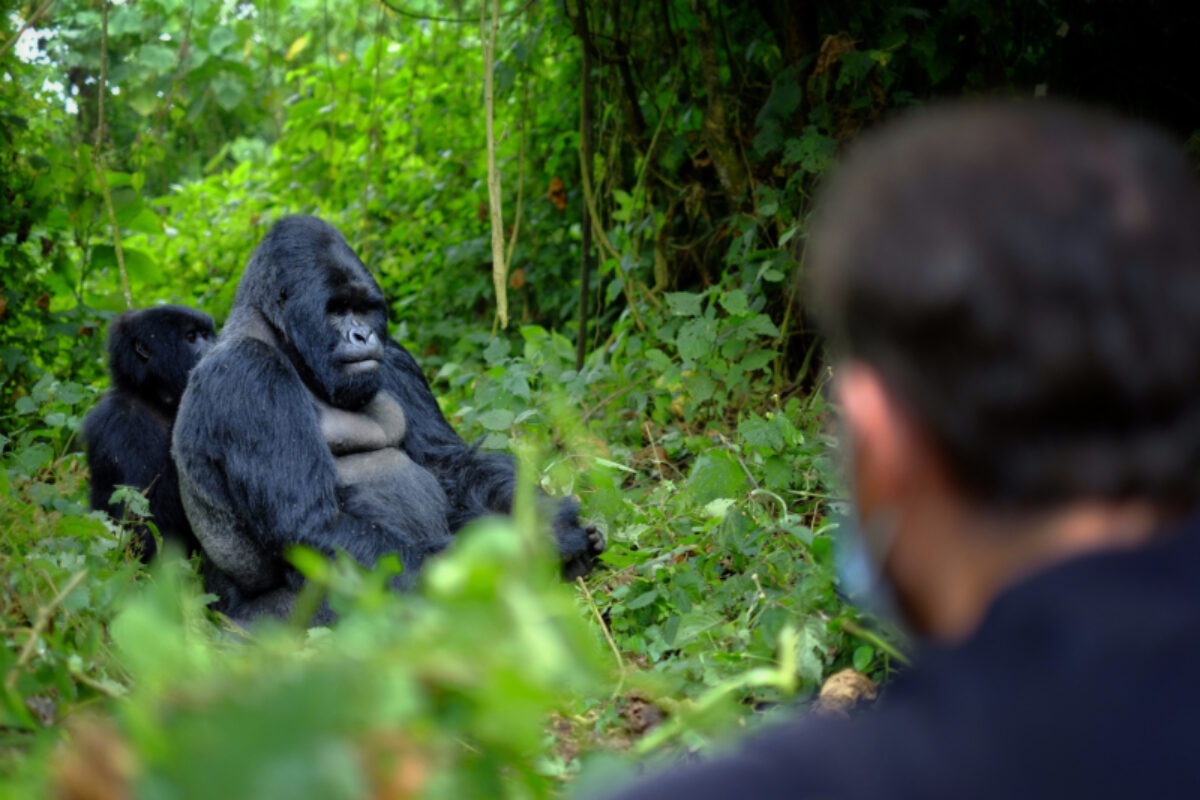
One magical moment: coming face to face with mountain gorillas in Uganda
Where to go gorilla trekking
The best places to see gorillas in the wild
Gorillas are creatures of the equatorial African rainforest, where their range is restricted to 10 countries. Only one species was recognised prior to 2001, when DNA tests revealed the eastern gorilla (Gorilla beringei) and western gorilla (G. gorilla) to be distinct species, both now red-listed as Critically Endangered by the IUCN. Each of these species is split into two subspecies. Best known is the mountain gorilla (G. b. beringei), which formed the subject of a celebrated research project initiated by Dian Fossey, of Gorillas in the Mist fame, in the 1960s. Of the four subspecies, the mountain gorilla – which occurs in Rwanda, Uganda and eastern DRC – is also the one most normally tracked by tourists. This is partly due to the Fossey connection, but mostly because both Uganda and Rwanda are stable countries with well-developed gorilla trekking industries.
-
Volcanoes National Park
-
Bwindi Impenetrable National Park
-
Mgahinga Gorilla National Park
-
Kahuzi-Biega National Park
-
Virunga National Park
-
East Africa
Gorilla trekking: Need to know
Everything you wish you'd known before you booked
Costs
A permit is required to see gorillas in any of the parks described above. It is illegal to track gorillas without this permit. And while the permits are relatively costly, the fee does help fund gorilla conservation and projects that benefit local communities.
The current cost of a permit for a foreign non-resident is USD $1,500 in Rwanda, USD $700 in Uganda and USD $400 in the DRC. This fee includes park entrance, and all guiding and tracking services (which are provided by the park, not by individual operators), but it does not include an optional porter to carry your day pack.
Other costs will depend on how you arrange your trip. Most visitors book an all-inclusive organised tour using midrange or luxury lodges. Standalone two- or three-day tours of this sort might cost anything from USD $1,500 per person to USD $5,000 and up, depending largely on the quality of accommodation. Many people also incorporate gorilla trekking with an extended tour of Uganda and/or Rwanda.
Although the permit fee for any given park is non-negotiable, it is possible to cut other costs by travelling independently, without a guide or operator. In my experience, this is perfectly safe, and a great way to experience local culture unfiltered by the tourist industry. Using public transport, the most accessible gorilla-tracking goals are Buhoma and Rushaga in Bwindi, both of which are accessible by bus and have a fair choice of affordable accommodation. If you are self-driving, any park in Uganda or Rwanda is a realistic goal. Note that in Uganda you can only secure a permit via an authorised tour operator, but you're free to make all the other travel arrangements yourself.
If the cost of a gorilla permit and accommodation feels too high, I often recommend chimpanzee trekking as a lower-cost alternative for budget-conscious travellers. And if you can afford both, it also makes an excellent add-on to a gorilla trek!
When to go
Gorilla treks run throughout the year. In Uganda, Rwanda and the DRC, the optimum time is the dry seasons, which run from June to August and December to February. Forest paths tend to be less slippery at this time of year, and the excursion is relatively unlikely to be interrupted by rain. Having said that, I’ve often tracked gorillas at the height of the rainy seasons, and would happily do so again.
How to book a gorilla trek
Permit availability is limited and is determined by the number of habituated gorilla families in each country. Permits can sell out months in advance, especially during peak season.
Gorilla tracking permit fees for foreigners are currently $1,500 in Rwanda and $700 in Uganda.
It's possible to organise a DIY gorilla trek in Rwanda by purchasing a permit directly from the Rwandan Development Board and then booking your own accommodation and transportation. In Uganda foreigners can only secure a permit via an authorised tour operator. My advice is to book through a good tour operator. A quality tour operator offers in-depth local knowledge with staff or representatives on-the-ground. They will have visited the lodges personally and be familiar with the proximity of each gorilla family. This knowledge can prove invaluable when planning your trek.
Tour operators should employ reliable ground staff, including good drivers who know the terrain well and can negotiate the steep dirt tracks (around Bwindi, for example).
If you plan to extend your trip after you have seen the gorillas, a tour operator can provide an itinerary and organise your other activities, accommodation and transfers.
Associations like the Association of Uganda Tour Operators and Rwanda Tours and Travel Association are professional bodies who vet their members but there are many good lodges and tour operators who are not members of these organisations.
You should book your gorilla trek and permit at least six months before you plan to travel. There are a limited number of permits available per day so tours do get booked up quickly.
Each gorilla permit only allows you to see gorillas for one hour, so if you want to make multiple visits, you will need multiple permits.
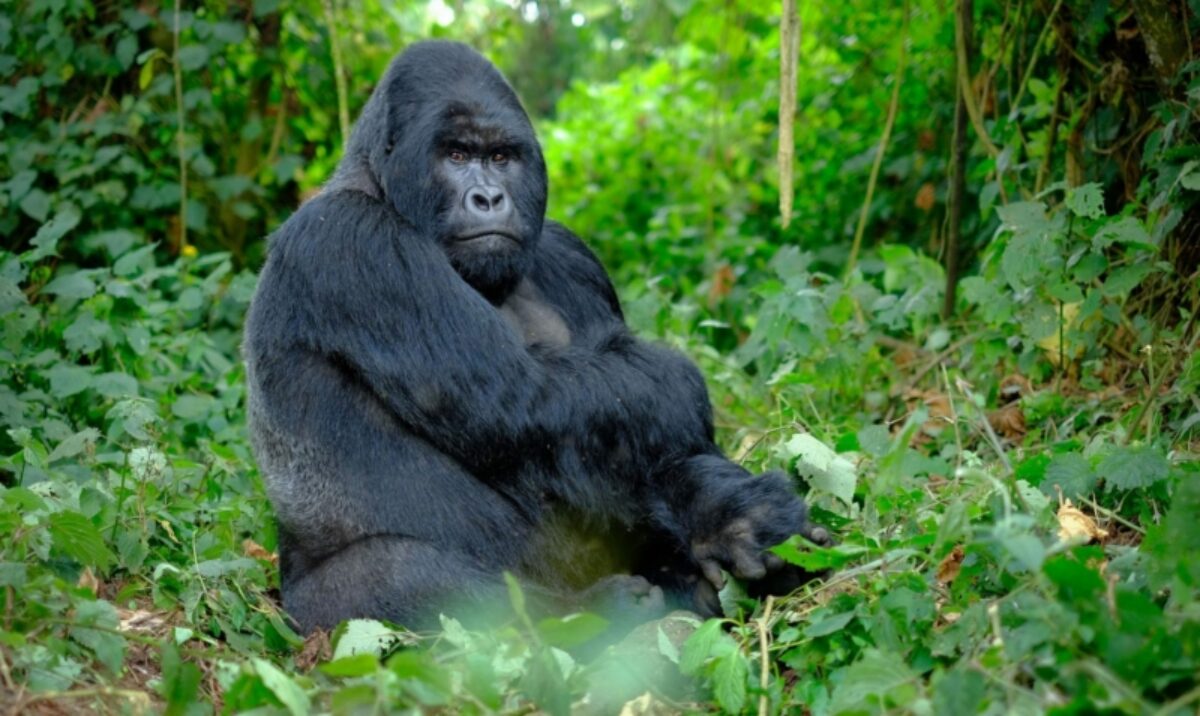
Up close and personal: Meeting a silverback on a gorilla trek in Rwanda
What to expect
Something almost everyone wants to know about gorilla trekking is how tough it is. This is a tricky question to answer because so many variables are involved. These include the difficulty of the terrain, weather conditions, and how long it takes to find the gorillas, all of which can vary from one day to the next. In my experience, however, moderately fit people under the age of 50 are unlikely to find the going particularly tough. Older and less fit travellers may find it more challenging; even so, the odds of locating gorillas is better than 99%, and your exhaustion is sure to dissipate when this happens.
Gorilla trekking rules & guidelines
Tourists are only allowed to visit and interact with habituated mountain gorilla families. Habituation is a gradual process through which the gorillas get used to the presence of humans. This allows people to visit the gorillas without affecting their daily lives or natural behaviour.
Although the gorillas are habituated, the Rwanda Development Board and the Uganda Wildlife Authority enforce strict rules governing how tourists can interact with the animals. The following are for the safety and wellbeing of the gorillas and tourists and are considered non-negotiable:
- Your group is allowed a maximum of one hour with the gorillas.
- Visitors must be over the age of 15.
- The maximum group size for tracking the gorillas is eight people (plus rangers and porters).
- Hiking in thick forest at an altitude of over 2,000 metres (6,560 ft) can be tough. It is often wet. Visitors must be fit and in good health.
- You should not visit the gorillas if you have Covid-19, diarrhoea, flu or a cold. Gorillas have no immunity to most human diseases and even mild human infections can be lethal to a gorilla. The Covid-19 pandemic made us even more aware of the risk we pose to them. You are obliged to inform the authorities if you are sick and they will decide if you are well enough to visit the gorillas. Remember that the lives of the endangered gorillas are more important than your holiday.
- If you need to sneeze or cough, cover your nose and mouth to reduce the chance of spreading infection.
- Don't spit or leave litter in the forest. Gorillas can catch diseases from human rubbish.
- Always leave a distance of ten metres between you and the gorillas. If the gorillas start moving towards you, the rangers may advise you to move away from them.
- Gorillas can be quite curious. Do not touch the gorillas, even if they come close to you.
- Do not make any sudden movements.
- If a gorilla charges, do not run away. Avoid direct eye contact until the gorilla has moved away. Stay calm and slowly crouch down.
- Stay in your group. Do not crowd or surround the gorillas.
- If you need to go to the toilet in the forest, tell your guide and he will dig a hole for you. Cover the hole afterwards to prevent spreading disease to the gorillas.
- Flash photography is strictly forbidden.
Follow these simple, common-sense rules and your gorilla trek will be a positive one—for the gorillas as well as yourself!
Gorilla trekking FAQs
Your questions, our expert answers
Question
We are six Baby Boomers planning to see the gorillas. One of us will be 82 and although in great shape, we won’t be able to hike for hours to see them. Will that work, and will there be porters to assist us?
Answer
This isn’t medical advice but it sounds to me like you'd be fine. I always recommend hiring a porter regardless of age; it's a huge help to have someone carry your stuff and leave your hands free for taking photos.
If you think you need some extra support you can hire a group to carry you on a rather unglamorously-named "stretcher" (it's better than it sounds!) You generally pay $10-$15 per person for the porter, and you might consider adding a tip of a similar amount. The "stretchers" cost around $100. These services are community-run initiatives and are a big boost to a family's income. All this can be arranged on the morning of your trek, during your briefing.
Also consider the location of your lodge and the gorilla family that you're assigned to track. Don't be shy in stating your tracking preferences during the morning briefing. The rangers want everyone to have a good – and safe – time so they will do their best to make sure that people with similar fitness levels are grouped together and assigned to track a more accessible gorilla family.
The Habinyanja family in Buhoma (Uganda) is well-known for being quite close to a number of the lodges. I tracked this same family a few years ago and had a lovely hour in search of them, before spending an hour with them. It took a little less than an hour to get back to the lodge, so about a three-hour round trip. Your tour operator should be able to identify a gorilla family and lodge combination that suits your fitness and ability levels.
Good preparation is also important. Local people love wearing gumboots (they keep out the ants as well as the mud) but walking boots with ankle support are the best option I'd say. I'd suggest bringing walking pole(s) or a stick. Sticks can also be bought or borrowed from your lodge.
Question
Is gorilla trekking worth the money?
Answer
If you do a search for this question you'll find hundreds of pages – mostly from companies selling gorilla treks – saying yes it's definitely worth the money. My reply is more qualified: if you have to ask, the answer might actually be no!
For many, seeing the gorillas is a once-in-a-lifetime experience. Personally I love it so much I’ve been four times!
But whether it is quite so life-changing for you depends on how passionate you are about wildlife encounters, hiking, (and early morning starts!) I actually think you’re most likely to be disappointed if your entire trip revolves around just seeing the gorillas – after your 60 minutes, the rest of the trip might feel anticlimactic. It should be regarded as a whole day’s activity in a pristine natural environment, not just the single hour with the great apes.
To get maximum value from the experience, make sure you’re prepared. Be as fit as possible, wear the right gear, rest well and don’t try to pack too many activities into your itinerary. These are both fascinating countries with much more than ‘just’ gorilla tracking; slow down and round out your experience by getting to know the rest of the country.
Question
Why are gorilla permits so expensive?
Answer
Seeing mountain gorillas in either country isn’t cheap. The combined cost of permits, accommodation, guides and a tour can bring overall trip costs upwards of $2,000 per person. So why are gorilla treks so expensive?
The main reason is that mountain gorillas are endangered and vulnerable to uncontrolled human interaction. One of the biggest threats to the gorillas’ survival is disease. Gorillas share 98% of their DNA with humans, making them highly susceptible to infection from human diseases. Therefore the authorities (wisely, in my opinion) tightly restrict and control the number of interactions the gorillas have with people.
And it takes money to protect the gorillas’ natural habitat. A significant percentage of gorilla permit fees goes into conserving the gorillas’ mountain forest habitat. Finally, some of the money you pay will go into research and monitoring of the gorillas, as well as paying your guides and encouraging sustainable tourism. The authorities point to the growth in gorilla numbers as evidence of their success.
On balance the price might not be low, but in my opinion it’s still pretty good value considering the importance of protecting this endangered primate.
Question
Is there an age limit?
Answer
The minimum age to visit gorillas in both countries is 15. You will need to provide your passport when you book your permits and park authorities will use your passport to verify your birthday matches the date given on your gorilla tracking permit.
Question
Is gorilla trekking safe?
Answer
Despite their size and unfair reputation, gorillas are not remotely dangerous provided they’re treated with appropriate respect. All gorilla treks are accompanied by expert ranger guides who spend most of their time with the mountain gorillas. You’re only allowed to visit gorilla groups who have been habituated to the presence of humans, meaning they are used to having people near them and understand that you’re not a threat.
Gorillas are normally shy and reserved, spending the majority of their time feeding and looking after their young. However, they—like any wild animal—can exhibit defensive behaviour if they feel uneasy, particularly around their young. Your guide will recognise the signs; they may include ‘mock charging’, aggressive beating of their chests and grunting. Always follow your guide’s lead, but if faced with an aggressive gorilla, crouch down, look away and try to act relaxed. Your guide will advise you further during the pre-trek briefing.
Question
Should I book a gorilla trek with a local or international operator?
Answer
There are many locally-based operators as well as international travel companies, often with stark price differences between the two. International travel companies often use local operators to run the ground operations, so you may wonder why you’re paying a premium to a middleman. Generally speaking international operators can offer an extra edge of communication, more hand-holding, and stronger financial protection. To help keep more of your money within the local economy I think it’s worth considering booking locally, but do check independent reviews and try to pay on a credit card and with travel insurance for financial protection.
Question
How close can you get to the mountain gorillas?
Answer
Regulations state that you must stay 10 metres from the gorillas at all times and only spend one hour with them. In practice, inquisitive gorillas may come closer to you on your trek. If they do, stay calm and quiet, follow your guide’s advice and never touch the gorillas. Keep your voice low and avoid eye contact.
The gorillas will normally be more relaxed the further back you are. Your guide may ask your group to move to a different location to calm the gorillas or to get a better view.
Question
What should I pack for a gorilla trek?
Answer
Your day of gorilla tracking will be long, active and may be fairly arduous. You’ll be hiking in thick forest in a changeable climate. Evenings can be cold; mornings are cool, and the days are hot—especially when you’re clambering up a muddy mountainside. Having the right gear makes all the difference:
A small backpack to carry water, packed lunch and rain jacket.
Walking boots or hiking shoes. Boots are ideal for the extra ankle support on rocky and muddy terrain. Another option (that is particularly popular with locals) is plastic gumboots. Not only do they keep your feet dry, but they keep insects—particular ants—at bay.
Long socks will allow you to tuck in your hiking trousers and protect your ankles from scratches and biting insects. Higher-end lodges may loan gaiters to guests.
Lightweight waterproof jacket.
Hiking pants or waterproof trousers (handy when sliding down muddy slopes!) Do not wear jeans or shorts: hiking in wet jeans can be miserable and shorts will leave you exposed to hungry insects and scratches from thorns.
A long-sleeved shirt offers much needed protection from the sun and insects.
A fleece or light-wool sweater for cold mornings.
Cheap gardening gloves will protect your hands but aren’t essential.
Sunglasses, sunscreen and sunhat.
Camera (and associated paraphernalia). Although some people take binoculars, you aren’t very likely to use them. You will spend most of your time in the forest where trees will obscure most things.
Many visitors—regardless of age or fitness—find walking poles useful and many upmarket lodges provide wooden poles. In VNP your guide can cut you a custom-made pole from bamboo!
At least one litre of drinking water and your packed lunch.
A basic first aid kit may come in handy: antiseptic wipes, antihistamine cream, insect repellent, plasters, painkillers, and rehydration sachets.

